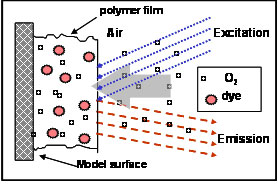The Polymer and Colloids Group
 During my first 10 years in Toronto, my students studied quenching of phosphorescence in solution, then a topical and typical area of mechanistic organic photochemistry. [see Macromolecules, 12, 902-905 (1979)] I abandoned this project in part because it seemed to have no practical applications. In the mid-1990s I was approached by De Havilland, a manufacturer of commuter airplanes, to help them implement a new method in aviation design, using oxygen quenching of phosphorescence from dyes in polymer films as a replacement for pressure sensors in wind-tunnel testing of aviation models. This technology is now known as "Pressure Sensitive Paint". We worked with my colleague Ian Manners, who synthesized new polymer resins, our Physics Department, which has expertise in digital imaging, the NRC wind tunnel facility in Ottawa, and with engineers at De Havilland. Our role was to develop the fundamental science relating surface oxygen pressure to the kinetics of phosphorescence quenching [see Chem. Phys. Lett., 261, 551-557 (1996)], and the methodology we developed provides precise data on the diffusivity and permeability of oxygen in polymer matrices. [see Adv. Mater., 8, 768-771 (1996)] We have also patented with Manners the first method for imaging the pressure profile of a rotating propeller in a wind tunnel.
During my first 10 years in Toronto, my students studied quenching of phosphorescence in solution, then a topical and typical area of mechanistic organic photochemistry. [see Macromolecules, 12, 902-905 (1979)] I abandoned this project in part because it seemed to have no practical applications. In the mid-1990s I was approached by De Havilland, a manufacturer of commuter airplanes, to help them implement a new method in aviation design, using oxygen quenching of phosphorescence from dyes in polymer films as a replacement for pressure sensors in wind-tunnel testing of aviation models. This technology is now known as "Pressure Sensitive Paint". We worked with my colleague Ian Manners, who synthesized new polymer resins, our Physics Department, which has expertise in digital imaging, the NRC wind tunnel facility in Ottawa, and with engineers at De Havilland. Our role was to develop the fundamental science relating surface oxygen pressure to the kinetics of phosphorescence quenching [see Chem. Phys. Lett., 261, 551-557 (1996)], and the methodology we developed provides precise data on the diffusivity and permeability of oxygen in polymer matrices. [see Adv. Mater., 8, 768-771 (1996)] We have also patented with Manners the first method for imaging the pressure profile of a rotating propeller in a wind tunnel.